Pedestrian crossing decisions can be explained by bounded optimal decision-making under noisy visual perception
Feb 06, 2024Yueyang Wang, Aravinda Ramakrishnan Srinivasan, Jussi P. P. Jokinen, Antti Oulasvirta, Gustav Markkula
This paper presents a model of pedestrian crossing decisions, based on the theory of computational rationality. It is assumed that crossing decisions are boundedly optimal, with bounds on optimality arising from human cognitive limitations. While previous models of pedestrian behaviour have been either 'black-box' machine learning models or mechanistic models with explicit assumptions about cognitive factors, we combine both approaches. Specifically, we model mechanistically noisy human visual perception and assumed rewards in crossing, but we use reinforcement learning to learn bounded optimal behaviour policy. The model reproduces a larger number of known empirical phenomena than previous models, in particular: (1) the effect of the time to arrival of an approaching vehicle on whether the pedestrian accepts the gap, the effect of the vehicle's speed on both (2) gap acceptance and (3) pedestrian timing of crossing in front of yielding vehicles, and (4) the effect on this crossing timing of the stopping distance of the yielding vehicle. Notably, our findings suggest that behaviours previously framed as 'biases' in decision-making, such as speed-dependent gap acceptance, might instead be a product of rational adaptation to the constraints of visual perception. Our approach also permits fitting the parameters of cognitive constraints and rewards per individual, to better account for individual differences. To conclude, by leveraging both RL and mechanistic modelling, our model offers novel insights about pedestrian behaviour, and may provide a useful foundation for more accurate and scalable pedestrian models.
Using Models Based on Cognitive Theory to Predict Human Behavior in Traffic: A Case Study
May 24, 2023Julian F. Schumann, Aravinda Ramakrishnan Srinivasan, Jens Kober, Gustav Markkula, Arkady Zgonnikov
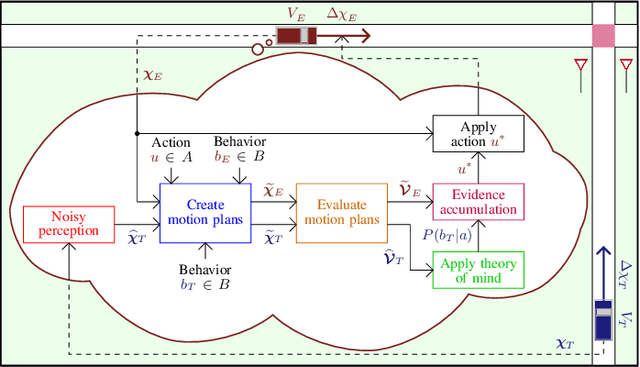
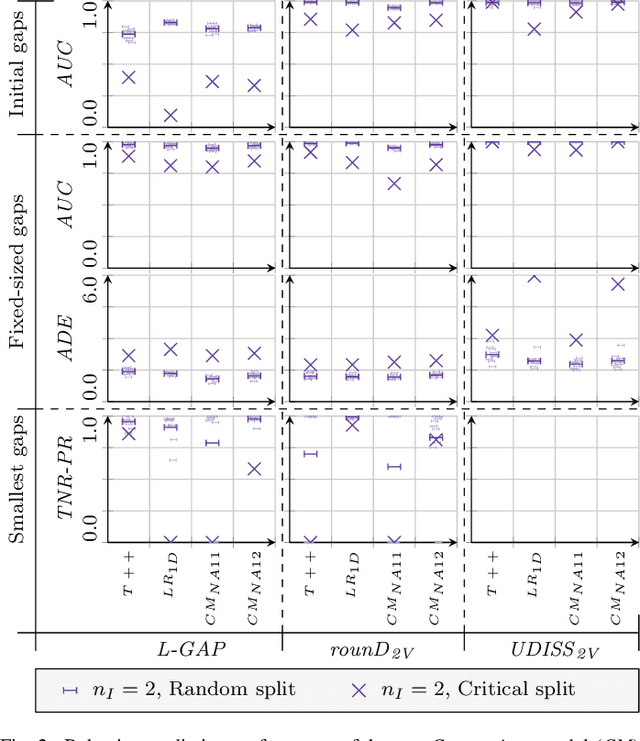

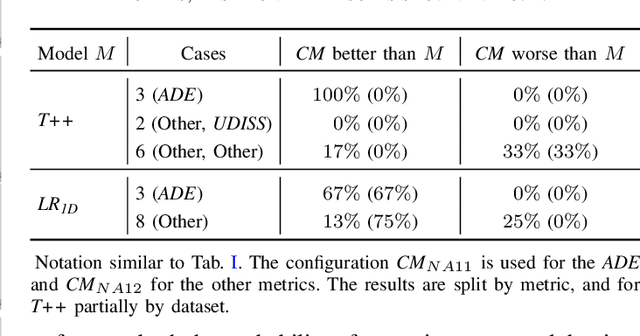
The development of automated vehicles has the potential to revolutionize transportation, but they are currently unable to ensure a safe and time-efficient driving style. Reliable models predicting human behavior are essential for overcoming this issue. While data-driven models are commonly used to this end, they can be vulnerable in safety-critical edge cases. This has led to an interest in models incorporating cognitive theory, but as such models are commonly developed for explanatory purposes, this approach's effectiveness in behavior prediction has remained largely untested so far. In this article, we investigate the usefulness of the \emph{Commotions} model -- a novel cognitively plausible model incorporating the latest theories of human perception, decision-making, and motor control -- for predicting human behavior in gap acceptance scenarios, which entail many important traffic interactions such as lane changes and intersections. We show that this model can compete with or even outperform well-established data-driven prediction models across several naturalistic datasets. These results demonstrate the promise of incorporating cognitive theory in behavior prediction models for automated vehicles.
Cross or Wait? Predicting Pedestrian Interaction Outcomes at Unsignalized Crossings
Apr 17, 2023Chi Zhang, Amir Hossein Kalantari, Yue Yang, Zhongjun Ni, Gustav Markkula, Natasha Merat, Christian Berger


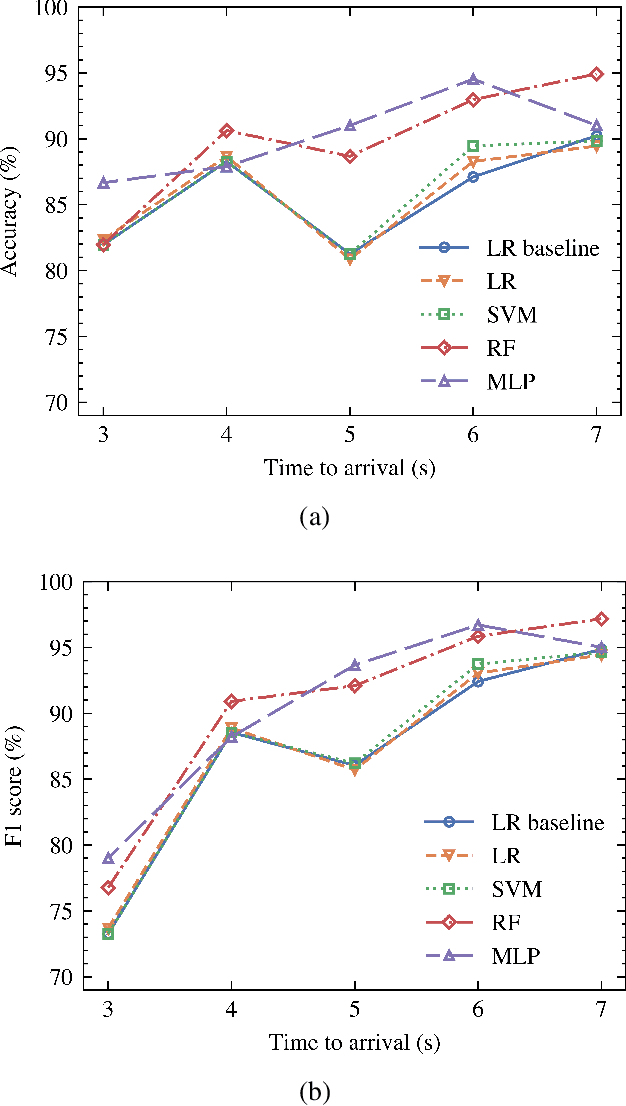
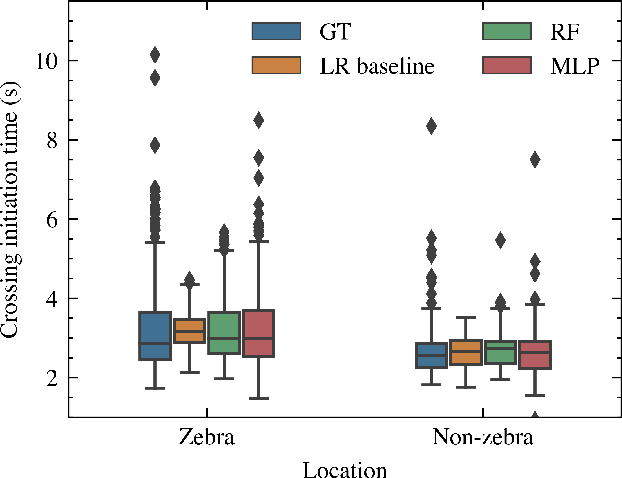
Predicting pedestrian behavior when interacting with vehicles is one of the most critical challenges in the field of automated driving. Pedestrian crossing behavior is influenced by various interaction factors, including time to arrival, pedestrian waiting time, the presence of zebra crossing, and the properties and personality traits of both pedestrians and drivers. However, these factors have not been fully explored for use in predicting interaction outcomes. In this paper, we use machine learning to predict pedestrian crossing behavior including pedestrian crossing decision, crossing initiation time (CIT), and crossing duration (CD) when interacting with vehicles at unsignalized crossings. Distributed simulator data are utilized for predicting and analyzing the interaction factors. Compared with the logistic regression baseline model, our proposed neural network model improves the prediction accuracy and F1 score by 4.46% and 3.23%, respectively. Our model also reduces the root mean squared error (RMSE) for CIT and CD by 21.56% and 30.14% compared with the linear regression model. Additionally, we have analyzed the importance of interaction factors, and present the results of models using fewer factors. This provides information for model selection in different scenarios with limited input features.
An active inference model of car following: Advantages and applications
Mar 27, 2023Ran Wei, Anthony D. McDonald, Alfredo Garcia, Gustav Markkula, Johan Engstrom, Matthew O'Kelly

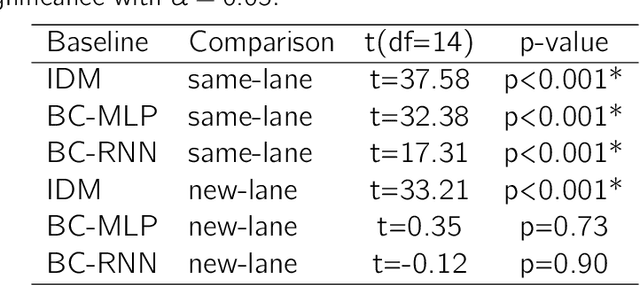
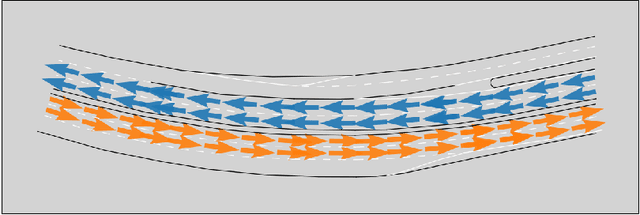
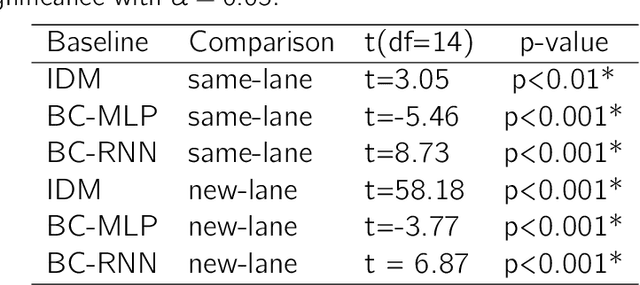
Driver process models play a central role in the testing, verification, and development of automated and autonomous vehicle technologies. Prior models developed from control theory and physics-based rules are limited in automated vehicle applications due to their restricted behavioral repertoire. Data-driven machine learning models are more capable than rule-based models but are limited by the need for large training datasets and their lack of interpretability, i.e., an understandable link between input data and output behaviors. We propose a novel car following modeling approach using active inference, which has comparable behavioral flexibility to data-driven models while maintaining interpretability. We assessed the proposed model, the Active Inference Driving Agent (AIDA), through a benchmark analysis against the rule-based Intelligent Driver Model, and two neural network Behavior Cloning models. The models were trained and tested on a real-world driving dataset using a consistent process. The testing results showed that the AIDA predicted driving controls significantly better than the rule-based Intelligent Driver Model and had similar accuracy to the data-driven neural network models in three out of four evaluations. Subsequent interpretability analyses illustrated that the AIDA's learned distributions were consistent with driver behavior theory and that visualizations of the distributions could be used to directly comprehend the model's decision making process and correct model errors attributable to limited training data. The results indicate that the AIDA is a promising alternative to black-box data-driven models and suggest a need for further research focused on modeling driving style and model training with more diverse datasets.
Modeling human road crossing decisions as reward maximization with visual perception limitations
Jan 27, 2023Yueyang Wang, Aravinda Ramakrishnan Srinivasan, Jussi P. P. Jokinen, Antti Oulasvirta, Gustav Markkula
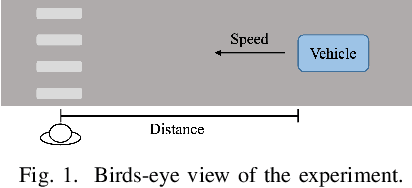
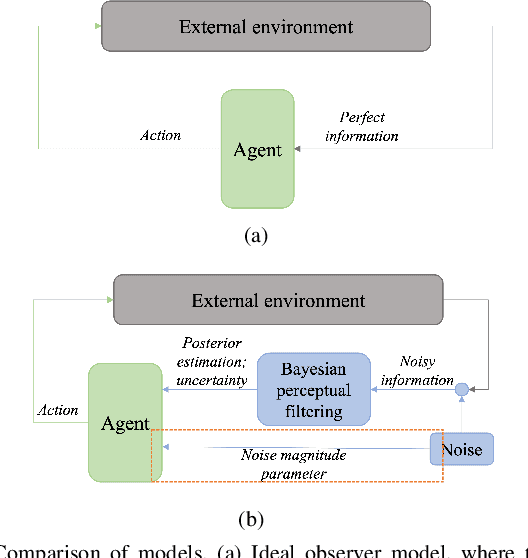

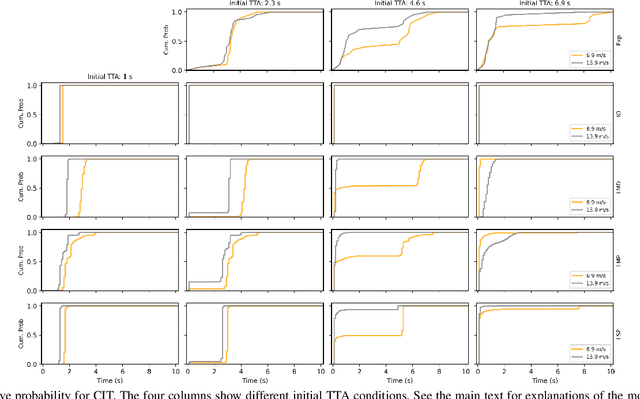
Understanding the interaction between different road users is critical for road safety and automated vehicles (AVs). Existing mathematical models on this topic have been proposed based mostly on either cognitive or machine learning (ML) approaches. However, current cognitive models are incapable of simulating road user trajectories in general scenarios, and ML models lack a focus on the mechanisms generating the behavior and take a high-level perspective which can cause failures to capture important human-like behaviors. Here, we develop a model of human pedestrian crossing decisions based on computational rationality, an approach using deep reinforcement learning (RL) to learn boundedly optimal behavior policies given human constraints, in our case a model of the limited human visual system. We show that the proposed combined cognitive-RL model captures human-like patterns of gap acceptance and crossing initiation time. Interestingly, our model's decisions are sensitive to not only the time gap, but also the speed of the approaching vehicle, something which has been described as a "bias" in human gap acceptance behavior. However, our results suggest that this is instead a rational adaption to human perceptual limitations. Moreover, we demonstrate an approach to accounting for individual differences in computational rationality models, by conditioning the RL policy on the parameters of the human constraints. Our results demonstrate the feasibility of generating more human-like road user behavior by combining RL with cognitive models.
Beyond RMSE: Do machine-learned models of road user interaction produce human-like behavior?
Jun 22, 2022Aravinda Ramakrishnan Srinivasan, Yi-Shin Lin, Morris Antonello, Anthony Knittel, Mohamed Hasan, Majd Hawasly, John Redford, Subramanian Ramamoorthy, Matteo Leonetti, Jac Billington, Richard Romano, Gustav Markkula
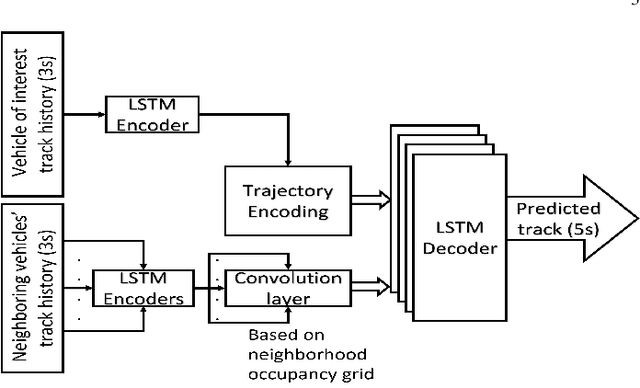
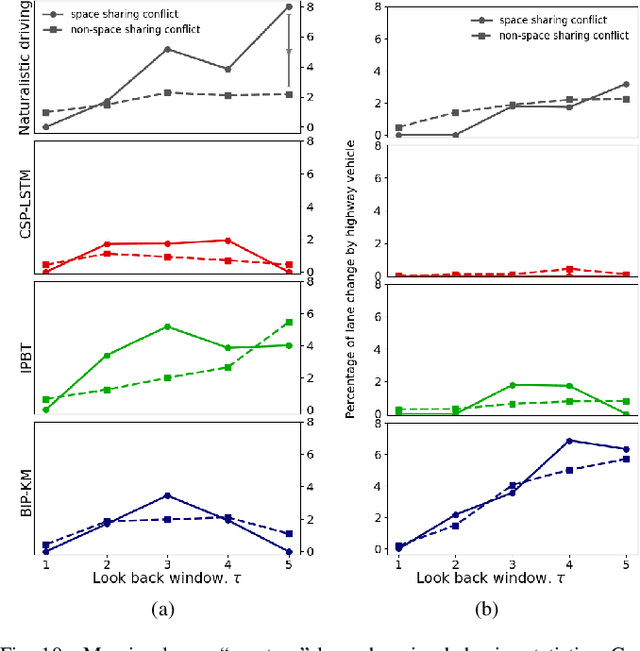
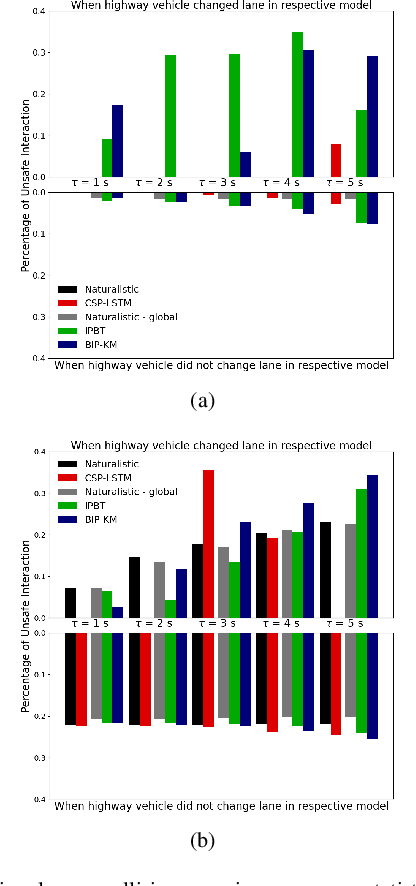
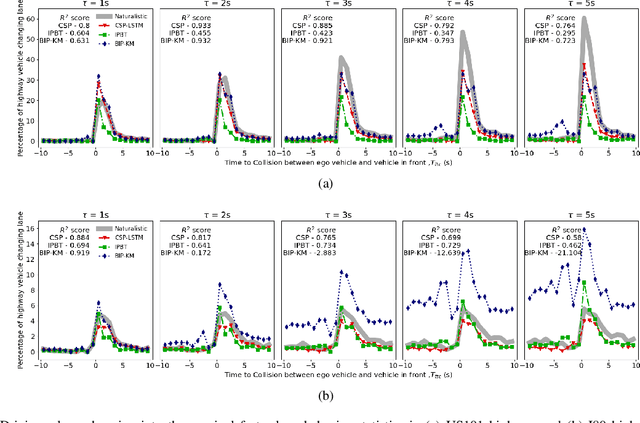
Autonomous vehicles use a variety of sensors and machine-learned models to predict the behavior of surrounding road users. Most of the machine-learned models in the literature focus on quantitative error metrics like the root mean square error (RMSE) to learn and report their models' capabilities. This focus on quantitative error metrics tends to ignore the more important behavioral aspect of the models, raising the question of whether these models really predict human-like behavior. Thus, we propose to analyze the output of machine-learned models much like we would analyze human data in conventional behavioral research. We introduce quantitative metrics to demonstrate presence of three different behavioral phenomena in a naturalistic highway driving dataset: 1) The kinematics-dependence of who passes a merging point first 2) Lane change by an on-highway vehicle to accommodate an on-ramp vehicle 3) Lane changes by vehicles on the highway to avoid lead vehicle conflicts. Then, we analyze the behavior of three machine-learned models using the same metrics. Even though the models' RMSE value differed, all the models captured the kinematic-dependent merging behavior but struggled at varying degrees to capture the more nuanced courtesy lane change and highway lane change behavior. Additionally, the collision aversion analysis during lane changes showed that the models struggled to capture the physical aspect of human driving: leaving adequate gap between the vehicles. Thus, our analysis highlighted the inadequacy of simple quantitative metrics and the need to take a broader behavioral perspective when analyzing machine-learned models of human driving predictions.
How accurate models of human behavior are needed for human-robot interaction? For automated driving?
Feb 12, 2022Gustav Markkula, Mehmet Dogar
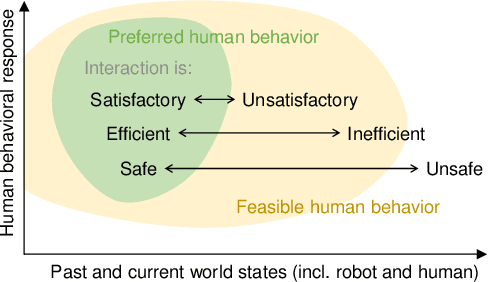
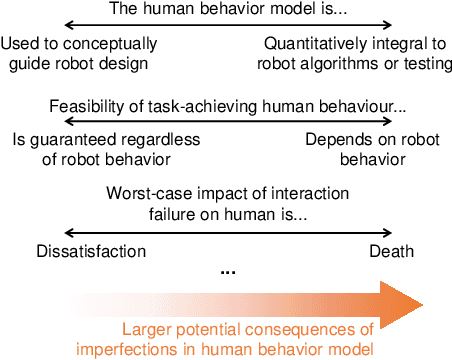
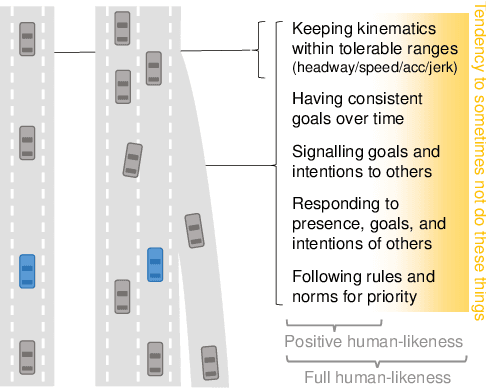
There are many examples of cases where access to improved models of human behavior and cognition has allowed creation of robots which can better interact with humans, and not least in road vehicle automation this is a rapidly growing area of research. Human-robot interaction (HRI) therefore provides an important applied setting for human behavior modeling - but given the vast complexity of human behavior, how complete and accurate do these models need to be? Here, we outline some possible ways of thinking about this problem, starting from the suggestion that modelers need to keep the right end goal in sight: A successful human-robot interaction, in terms of safety, performance, and human satisfaction. Efforts toward model completeness and accuracy should be focused on those aspects of human behavior to which interaction success is most sensitive. We emphasise that identifying which those aspects are is a difficult scientific objective in its own right, distinct for each given HRI context. We propose and exemplify an approach to formulating a priori hypotheses on this matter, in cases where robots are to be involved in interactions which currently take place between humans, such as in automated driving. Our perspective also highlights some possible risks of overreliance on machine-learned models of human behavior in HRI, and how to mitigate against those risks.
A Utility Maximization Model of Pedestrian and Driver Interactions
Oct 21, 2021Yi-Shin Lin, Aravinda Ramakrishnan Srinivasan, Matteo Leonetti, Jac Billington, Gustav Markkula
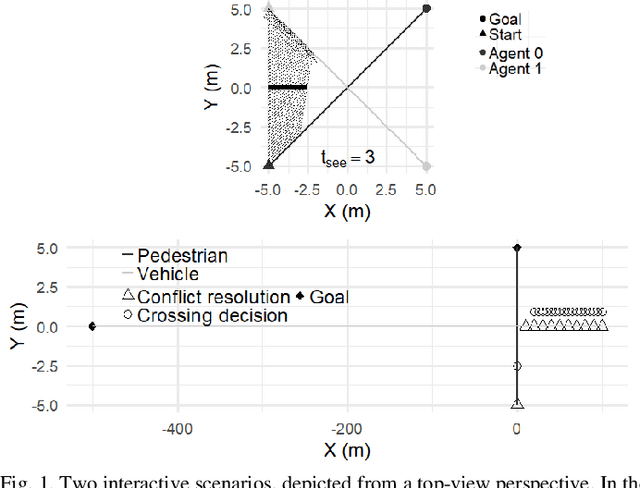
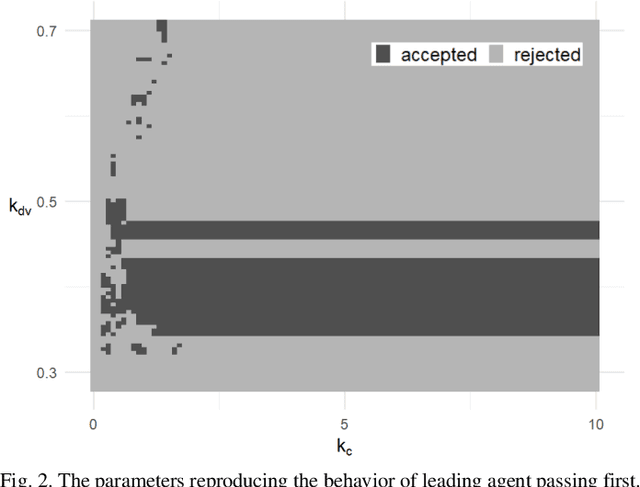
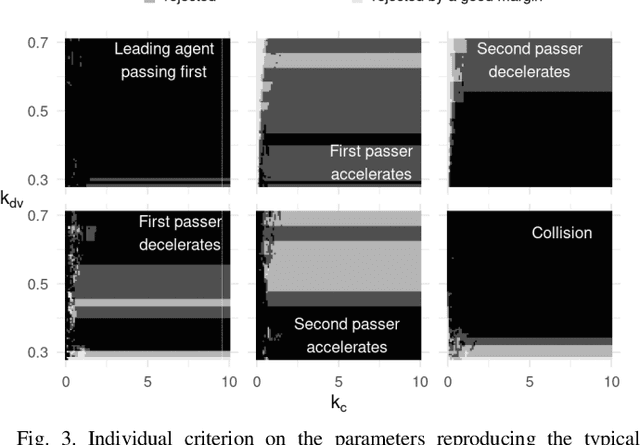
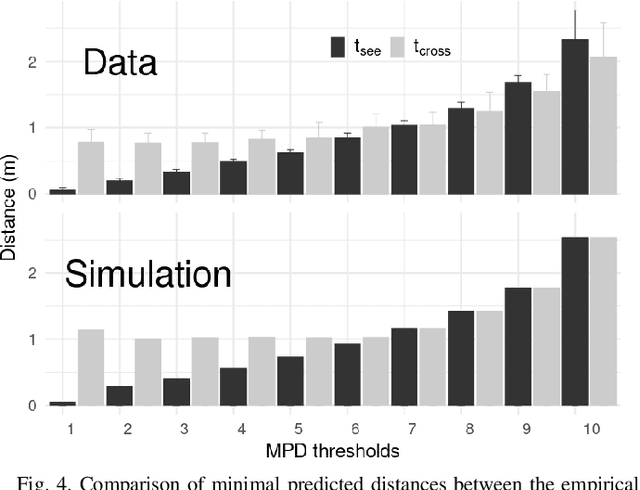
Many models account for the traffic flow of road users but few take the details of local interactions into consideration and how they could deteriorate into safety-critical situations. Building on the concept of sensorimotor control, we develop a modeling framework applying the principles of utility maximization, motor primitives, and intermittent action decisions to account for the details of interactive behaviors among road users. The framework connects these principles to the decision theory and is applied to determine whether such an approach can reproduce the following phenomena: When two pedestrians travel on crossing paths, (a) their interaction is sensitive to initial asymmetries, and (b) based on which, they rapidly resolve collision conflict by adapting their behaviors. When a pedestrian crosses the road while facing an approaching car, (c) either road user yields to the other to resolve their conflict, akin to the pedestrian interaction, and (d) the outcome reveals a specific situational kinematics, associated with the nature of vehicle acceleration. We show that these phenomena emerge naturally from our modeling framework when the model can evolve its parameters as a consequence of the situations. We believe that the modeling framework and phenomenon-centered analysis offer promising tools to understand road user interactions. We conclude with a discussion on how the model can be instrumental in studying the safety-critical situations when including other variables in road-user interactions.
Maneuver-Aware Pooling for Vehicle Trajectory Prediction
Apr 29, 2021Mohamed Hasan, Albert Solernou, Evangelos Paschalidis, He Wang, Gustav Markkula, Richard Romano


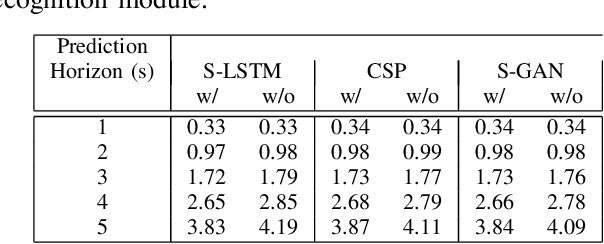

Autonomous vehicles should be able to predict the future states of its environment and respond appropriately. Specifically, predicting the behavior of surrounding human drivers is vital for such platforms to share the same road with humans. Behavior of each of the surrounding vehicles is governed by the motion of its neighbor vehicles. This paper focuses on predicting the behavior of the surrounding vehicles of an autonomous vehicle on highways. We are motivated by improving the prediction accuracy when a surrounding vehicle performs lane change and highway merging maneuvers. We propose a novel pooling strategy to capture the inter-dependencies between the neighbor vehicles. Depending solely on Euclidean trajectory representation, the existing pooling strategies do not model the context information of the maneuvers intended by a surrounding vehicle. In contrast, our pooling mechanism employs polar trajectory representation, vehicles orientation and radial velocity. This results in an implicitly maneuver-aware pooling operation. We incorporated the proposed pooling mechanism into a generative encoder-decoder model, and evaluated our method on the public NGSIM dataset. The results of maneuver-based trajectory predictions demonstrate the effectiveness of the proposed method compared with the state-of-the-art approaches. Our "Pooling Toolbox" code is available at https://github.com/m-hasan-n/pooling.
Maneuver-based Anchor Trajectory Hypotheses at Roundabouts
Apr 22, 2021Mohamed Hasan, Evangelos Paschalidis, Albert Solernou, He Wang, Gustav Markkula, Richard Romano
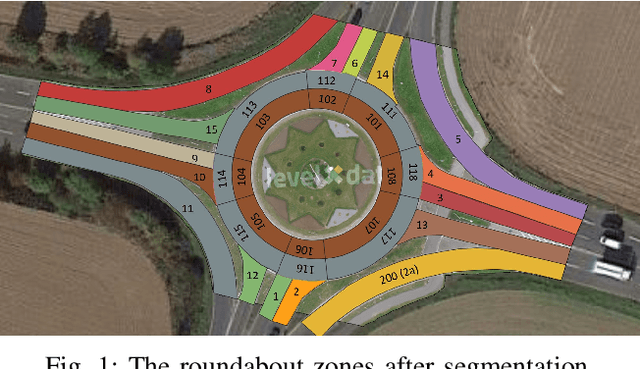
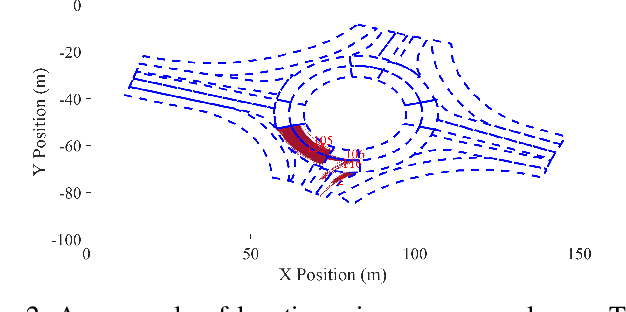
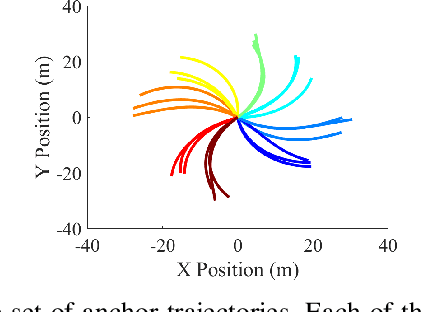

Predicting future behavior of the surrounding vehicles is crucial for self-driving platforms to safely navigate through other traffic. This is critical when making decisions like crossing an unsignalized intersection. We address the problem of vehicle motion prediction in a challenging roundabout environment by learning from human driver data. We extend existing recurrent encoder-decoder models to be advantageously combined with anchor trajectories to predict vehicle behaviors on a roundabout. Drivers' intentions are encoded by a set of maneuvers that correspond to semantic driving concepts. Accordingly, our model employs a set of maneuver-specific anchor trajectories that cover the space of possible outcomes at the roundabout. The proposed model can output a multi-modal distribution over the predicted future trajectories based on the maneuver-specific anchors. We evaluate our model using the public RounD dataset and the experiment results show the effectiveness of the proposed maneuver-based anchor regression in improving prediction accuracy, reducing the average RMSE to 28% less than the best baseline. Our code is available at https://github.com/m-hasan-n/roundabout.
 Add to Chrome
Add to Chrome Add to Firefox
Add to Firefox Add to Edge
Add to Edge